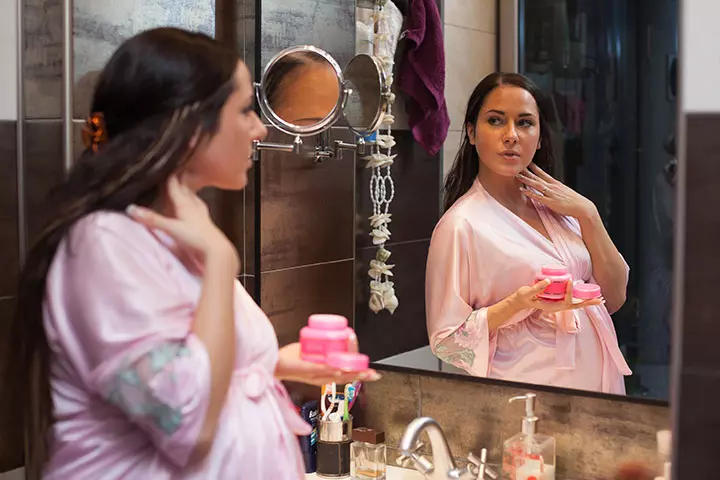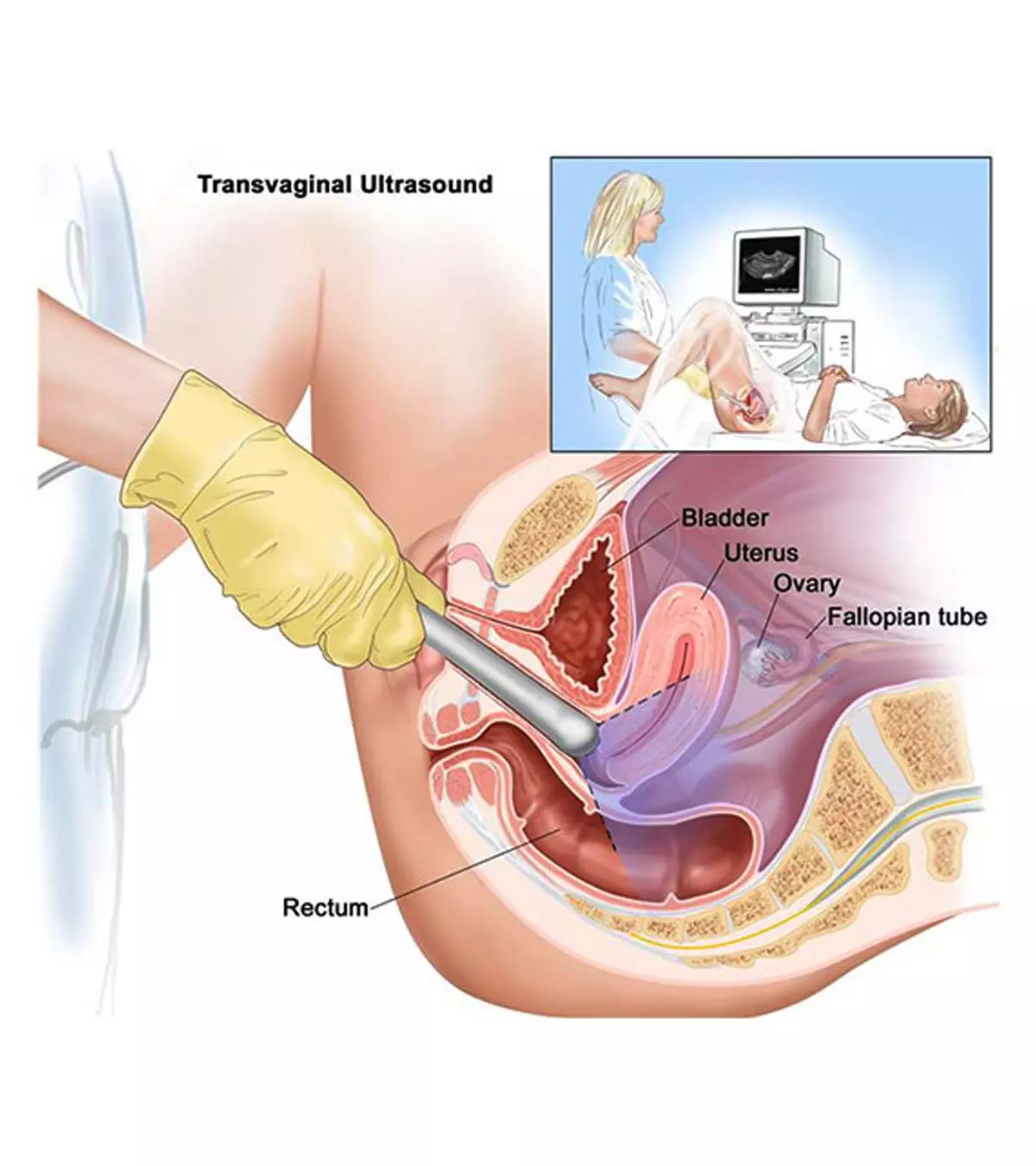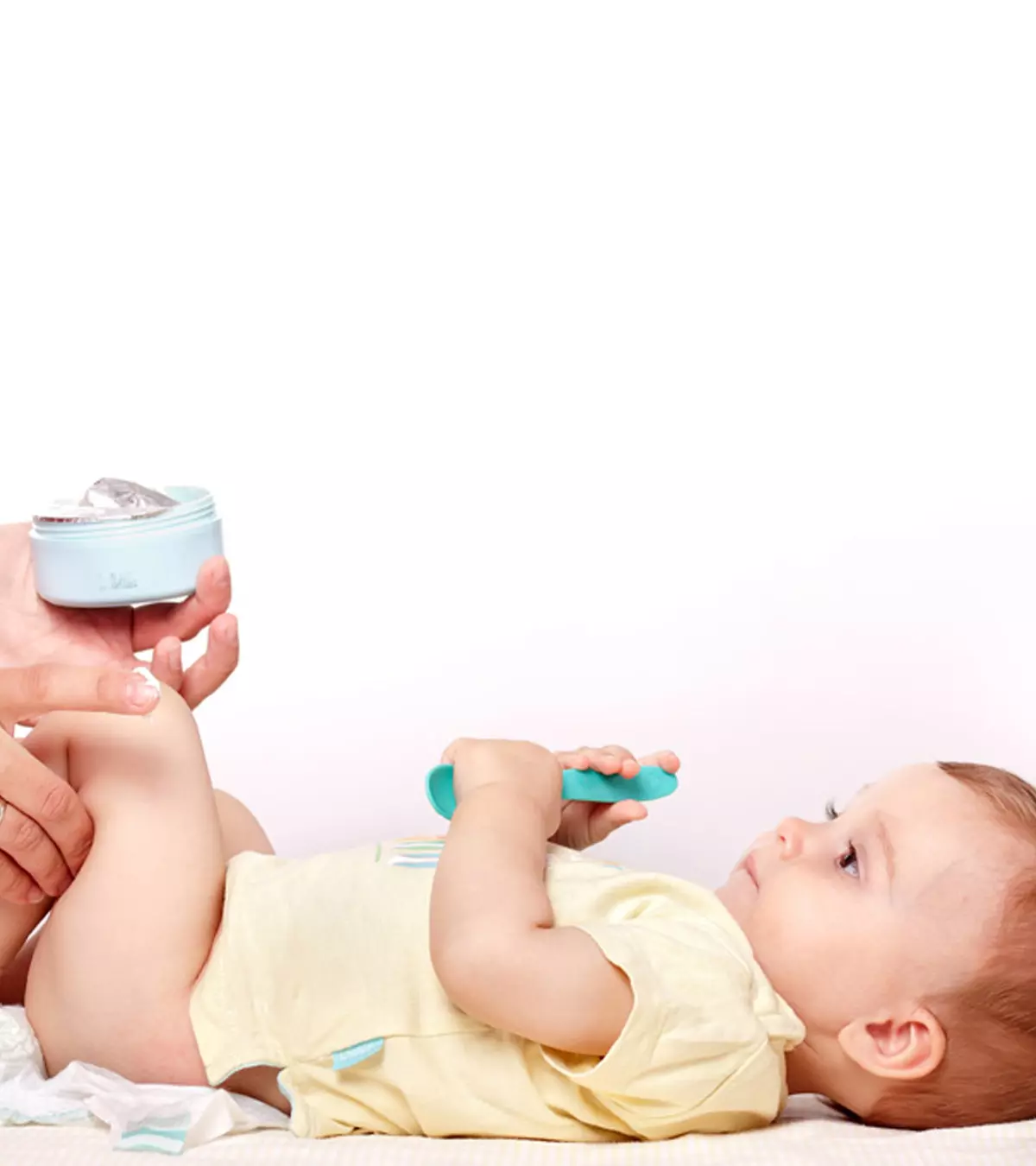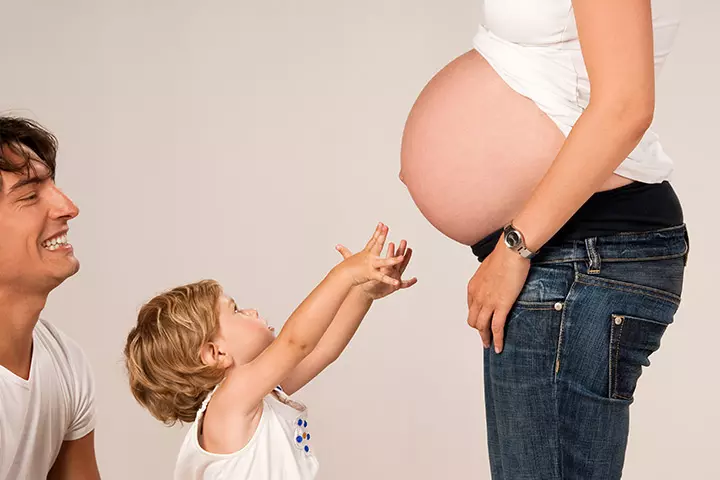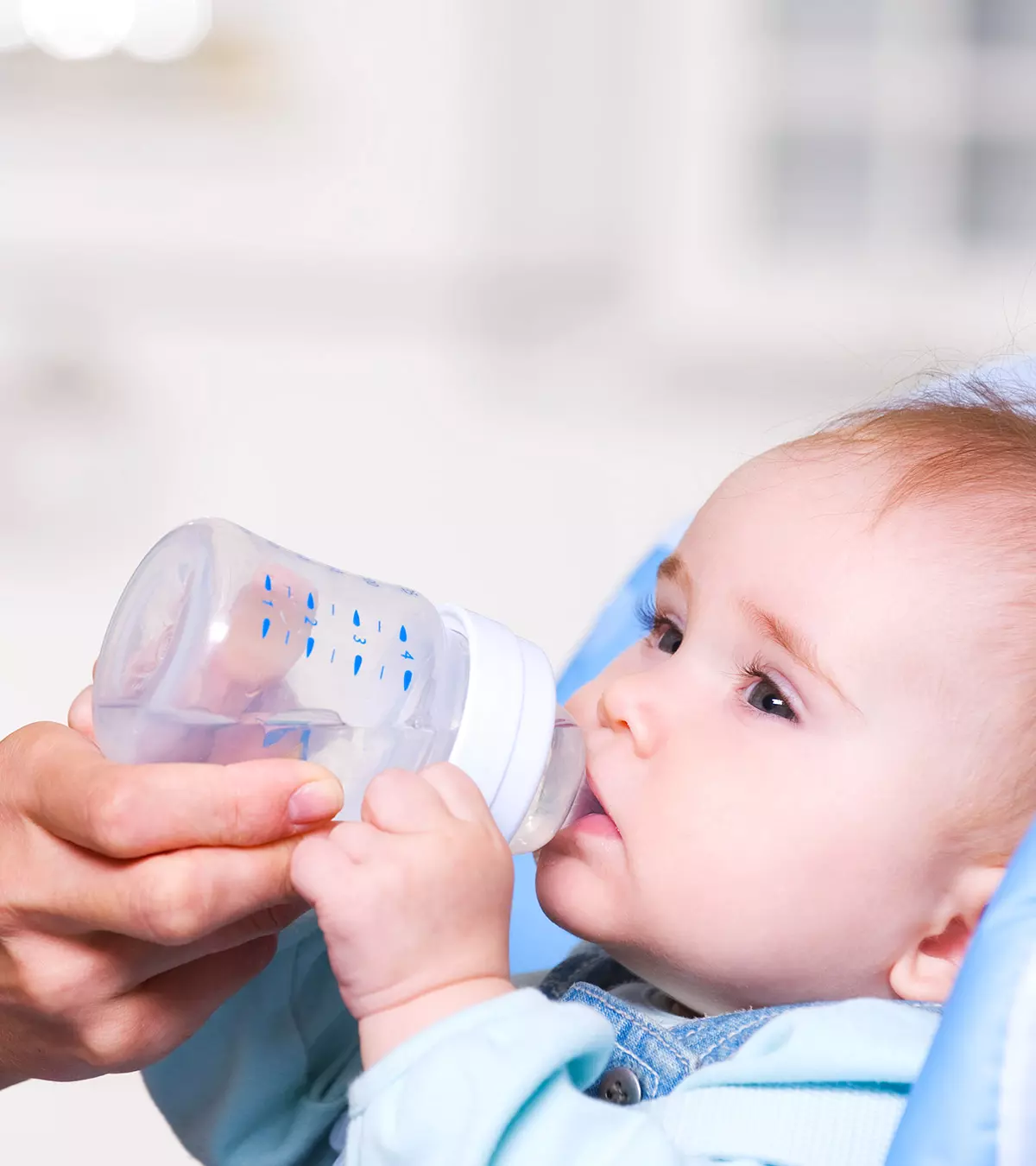
Image: ShutterStock
It is important to wear the right pregnancy bra to keep your breasts supported and comfortable. As your pregnancy progresses, your breasts may change in size and shape due to hormonal fluctuations. Hence, you may need to upgrade your bra according to the changes in your breasts.

Read this post to learn more about the right time to buy a new bra, the difference between regular, maternity, and nursing bras, how to measure your breast size to find the correct bra, how many maternity lingeries or nursing bras you may need, and whether underwire bras are safe during pregnancy and nursing. This post also discusses whether sleep and sports bras for pregnancy are helpful.
Key Pointers
- Maternity bras can support the growing breast during pregnancy, which occurs as a result of hormonal changes.
- Choose a cotton bra with wide straps, support panels, and adjustable fastenings for optimal comfort.
- Avoid tight, uncomfortable, underwired, laced, or synthetic-fabric bras as they may not offer adequate support.
- When engaging in physical activities like yoga or walking, consider a maternity sports bra for added support and comfort.
Do You Need A New Bra During Pregnancy?

During pregnancy, your breasts become bigger and sensitive, which is why you need a comfortable and supportive bra.
The hormonal fluctuations, expanding rib cage, weight gain and production of milk in the mammary glands late in the pregnancy, are a few factors that lead to breast enlargement. This makes it necessary to invest in a perfectly fitting support bra for optimal breast care during pregnancy (1).
When Is The Right Time To Buy A New Bra?

It is the time to buy a new bra when:
- You see indentations of the band and straps while removing the bra
- Breasts spill over the cups
- You feel the bra is tight-fitting
- You start feeling uncomfortable with your normal underwire bras
- Shortness of breath or a feeling of being unable to take a deep breathe might mean the bra is too tight around the chest
Not all women experience the same physiological changes during pregnancy. Some may find their cup size increasing throughout pregnancy, while some might notice growth in the first trimester and the last. Changes in the breast sizes usually happen around the third month of pregnancy, i.e. after 12 weeks. You can purchase a new bra after that when the breast growth stabilizes.
 Point to consider
Point to considerWhat Is The Difference Between Regular, Maternity And Nursing Bras?
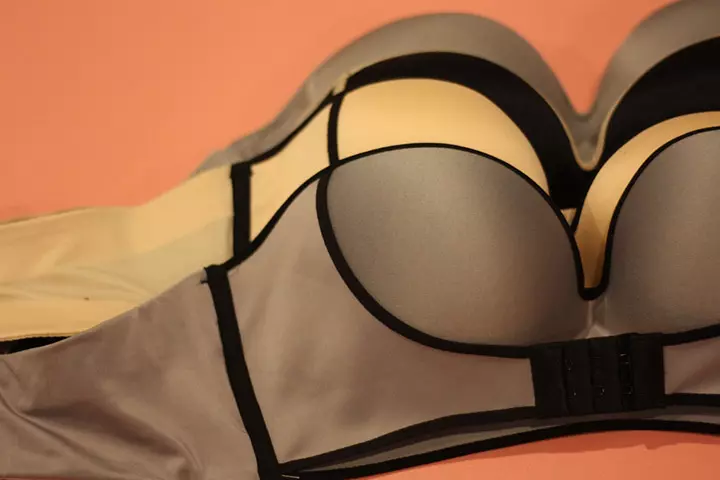
A regular bra comes in various colors, styles and comfort levels. They are designed for breasts that are less heavy and sensitive. They have a single layer of fabric with inferior underwires and lace trims.
A maternity bra is an enhanced version of a regular bra specially designed to offer support to the growing breasts. It has a soft cotton lining, extra layers of fabric, wider straps, a band with extra hooks and eyes for easy adjustment (2). Maternity bras do not have the underwire cups that regular bras have. So, you can go for a seamless bra or a wireless bra, as they can nurture your growing breasts.
A nursing bra has an extra feature – panels or clasps which can be opened to expose the nipples for breastfeeding. They are designed with a heavy bust and reinforced lower cups, supportive straps, double layered back, wider back band, extra hooks and eyes. Full-coverage bras are usually made for nursing mothers.
You can switch to nursing or breastfeeding bras in the middle of the third trimester, as they serve a dual purpose of giving the breasts enough room to grow, and making breastfeeding convenient for you. Investing in nursing bras can be a good way to cut down on maternity expenses.
The best bra to wear during pregnancy is the one that is supportive and comfortable. But it is not easy to know which type fits you the best.
How To Buy The Right Pregnancy Bra?

Here are some tips that help you choose the right-fitting pregnancy bra:
- Choose a bra that is neither too loose nor too tight. If you are unsure of your exact size, an adjustable bra is a good option.
- It should be made of a light, breathable fabric, preferably cotton and not laced and synthetic fabrics.
- It should be a wide strap bra with adjustable support panels and back fastenings to support your growing breasts during lactation and post-delivery.
- The bra should be able to cover the entire breast, without any bulges at the top, bottom or the sides of the cups. Plus-size maternity bras are a good option for women needing more support and coverage. These bras are designed to accommodate breast size and shape changes and often have wider straps and a more supportive band.
- If the straps of the bra cut into your shoulder line and cause pain and discomfort when you are lactating, it indicates that the bra is not of the right fit. The shoulder straps should stay in their place without digging in, even when you stretch your arms or upper body.
- The nipples should point straight ahead and not lie down or point up when you wear the right bra.
- The bra hook strap at the back should be in the right position; it shouldn’t be pointing towards your upper back.
- Avoid hardwired or underwired bras during pregnancy. You may find them digging into the skin at different places, which is not at all comfortable.
How To Measure Your Size For Maternity And Nursing Bras?
Measuring bra size involves two components – band size (for instance 34, 36, 38) and cup size (A, B, C, and more.).
1. Measure the band size
Wear a comfortable regular bra and stand in front of a mirror. Let your back and shoulders be straight (relax and do not hold your breath). Wrap the tape around your chest where the band sits and ensure it is intact (not too loose or tight). If the measurement is an odd number, count the next even number.
2. Measure the bust size
Wrap the tape loosely around your breast, at the tips. Hold the tape around the body fairly loose. Round up to the nearest number.
3. Calculate the cup size
Subtract the band size from the bust size to get your cup size.
| BUST MINUS BAND DIFFERENCE | US CUP SIZES | EUROPEAN | UK |
|---|---|---|---|
| less than 1″ | AA | AA | AA |
| 1″ | A | A | A |
| 2″ | B | B | B |
| 3″ | C | C | C |
| 4″ | D | D | D |
| 5″ | DD/E | E | DD |
| 6″ | DDD/F | F | E |
| 7″ | DDDD/G | G | F |
| 8″ | DDDDD/H | H | FF |
| 9″ | DDDDDD/I | I | G |
| 10″ | J | J | GG |
| 11″ | K | H | |
| 12″ | L | HH | |
| 13″ | M | J | |
| 14″ | N | JJ | |
| 15″ | K |
For example:
Band size – 38”
Bust size – 41”
Cup size – 41”-38” = 3”, cup size C.
Therefore, your bra size will be 38C.
So, got a fair idea of what type and size of bras to buy during pregnancy? Read further as we answer some more queries you might have on maternity bras.
Tips For Buying The Right Fit Bra
Here are the signs of a good fit and an ill-fit bra.
| Signs of a well-fitting bra |
|---|
| Breasts are completely inside the cups |
| No wrinkles or bumps develop in the cups |
| The middle section of the bra, between the breasts, is flat. |
| If there is an underwire, it should not touch your breast tissue and must lie flat on the chest |
| Rib band of the bra sits below the shoulder blades |
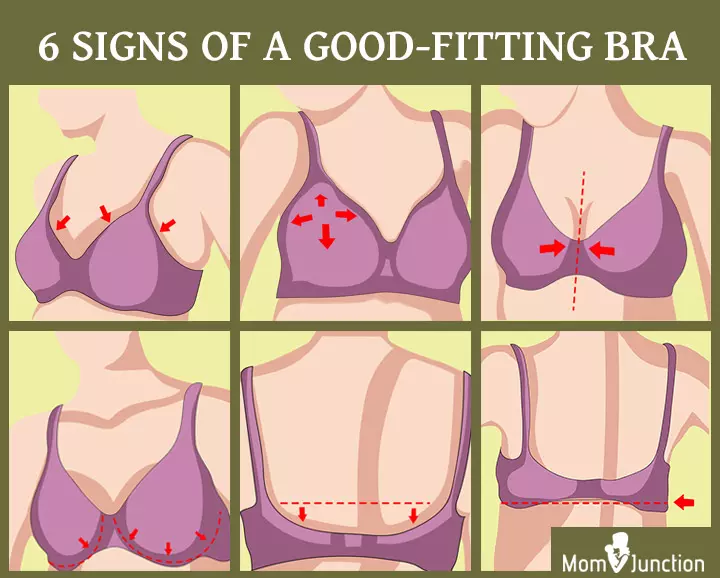
| Signs of an ill-fitting bra |
|---|
| Breasts spill over the top or sides of the bra |
| Straps keep falling off the shoulders |
| Bra straps dig into the shoulders |
| Breasts have no lift or support and sag |
| Back band keeps riding upwards |

How Many Maternity Or Nursing Bras Do I Need?
You can buy two to three maternity bras and keep rotating them between wash and wear. Ideally, you will need three nursing bras, one to wear, one to launder, and one as a spare. This will help you be ready for any unexpected leak, baby spit-up, or hot flash. You can go for the next set once you feel the need for a better fit.
Why Are Underwire Bras Not Safe During Pregnancy And Nursing?
The only concern with underwire bras is they can alter the blood flow and affect the milk production or lead to clogged ducts or mastitis (inflamed breast tissue)
. Hence, it is better to go for an underwire-free bra while pregnant. A non-restrictive bra without underwire allows for more flexibility and is less likely to cause discomfort or irritation.
How Are Sleep Bra And Sports Bra Helpful During Pregnancy?
Sleeping during pregnancy can be problematic when your tender breasts press against the bed. A good sleep bra for pregnancy will provide gentle support to your breast while sleeping, almost making you feel like you’re not wearing one.
 Quick tip
Quick tipIf you plan to exercise or head to a gym for a workout or to practice yoga, a maternity sports bra or moisture-wicking bras designed for pregnant women would be a good choice. These bras offer enough support while preventing any friction when you move. They come with extra back support.
The bra gives a shape to your breasts. And the right bra gives the right shape. It not only makes you feel comfortable but also confident. You do not have to feel conscious about the wrongly shaped breasts when you go out or even at home or work.
Frequently Asked Questions
1. Can I wear regular bras while pregnant?
Yes, you may wear a regular bra during pregnancy if you are comfortable with it. A pregnancy bra could be better suited since it is specifically designed to provide more support to the growing breasts.
2. Is it okay not to wear a bra during pregnancy?
Wearing or not wearing a bra during pregnancy is a matter of personal choice and comfort. You may skip wearing a bra during pregnancy if you are not comfortable with it.
3. How do you care for your pregnancy bras?
Pregnancy bras are often made of delicate fabrics. Hence, it is generally recommended to hand wash them with mild soap. You should avoid soaking them in bleachy solutions, as bleach could weaken the fabric. In addition, bleach residue on the material could cause skin irritation near and under the breast (3).
4. Can a pregnancy bra help with back pain and discomfort during pregnancy?
Pregnancy bras are designed to provide additional breast support that helps alleviate the strain on the ligaments and muscles in the chest and back area. They also often have wider shoulder straps that distribute the weight of the breasts evenly. Moreover, some pregnancy bras have built-in back support features such as wider back panels or additional hooks and closures. It is a combination of these features that help support the back, maintain proper posture, and reduce back pain.
5. What materials are pregnancy bras made of?
Pregnant women should wear bras made of breathable fabric, such as those made of natural fiber fabrics like silk and cotton (4). These fabrics are more breathable and comfortable to wear than synthetic fabrics like polyester.
Pregnancy causes the breasts to change in size and shape; therefore, using a good pregnancy bra is essential for optimum comfort and support. These bras are made with soft fabric, have wider straps, and are easy to adjust. If you notice your bras are suddenly tight, your breasts are spilling over, or you experience shortness of breath due to a tight chest, you know that you require a new bra. A proper pregnancy bra will keep your breasts inside the cups and not cause wrinkles over them.
Infographic: Maternity Bra: Right Fit And Care
Wearing a clean, well-fit bra during pregnancy is essential to keep your breasts healthy and comfortable. Our infographic shares simple tips on how you can care for your maternity bra so they may stay usable for longer. Also, we give you an insight into potential problems that a wrong or ill-fitted bra can cause.
Some thing wrong with infographic shortcode. please verify shortcode syntax
Learn how to properly adjust your maternity bra in 5 easy steps! Through this informative video, you may achieve the optimal fit that matches your evolving body.
References
- Caring for Yourself During Pregnancy & Beyond; UCSF Medical Center
https://obgyn.ucsf.edu/sites/obgyn.ucsf.edu/files/UCSF_PregGuidebook_June2017.pdf - Pregnancy Discomforts: Back Pain Round Ligament Pain Nausea; Cleveland clinic
https://my.clevelandclinic.org/health/articles/pregnancy-pains - Choosing a maternity bra; Australian Breastfeeding Association
https://www.breastfeeding.asn.au/resources/choosing-maternity-bra - Maternity bras and nursing bras: what you need to know; NCT UK
https://www.nct.org.uk/pregnancy/worries-and-discomforts/common-discomforts/maternity-bras-and-nursing-bras-what-you-need-know
Community Experiences
Join the conversation and become a part of our nurturing community! Share your stories, experiences, and insights to connect with fellow parents.
Read full bio of Cheryl Rowe
Read full bio of Rebecca Malachi
Read full bio of Swati Patwal
Read full bio of Aneesha Amonz





